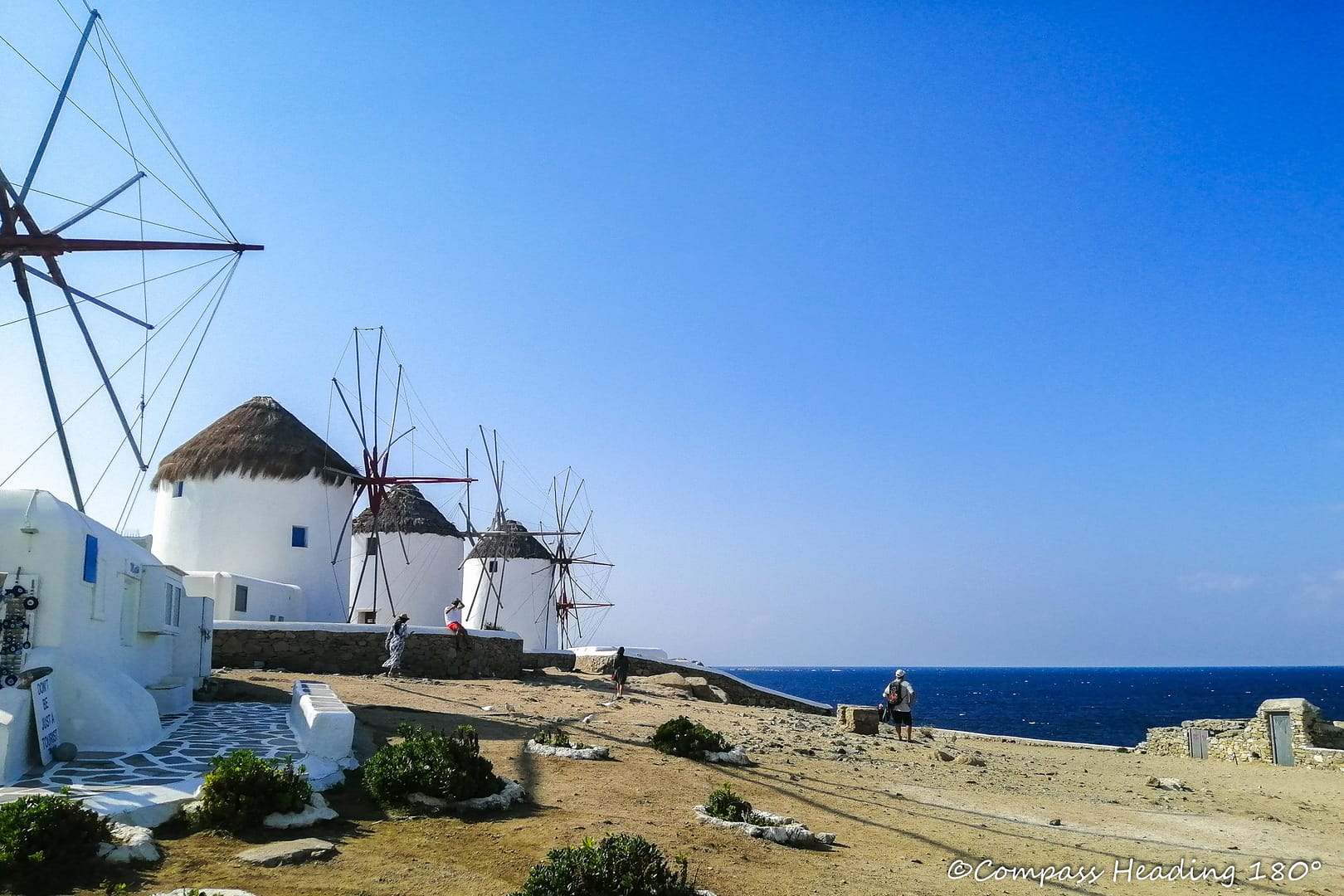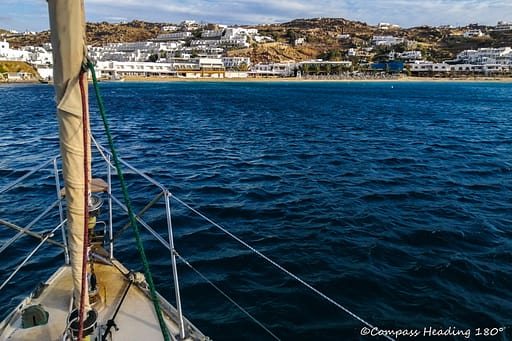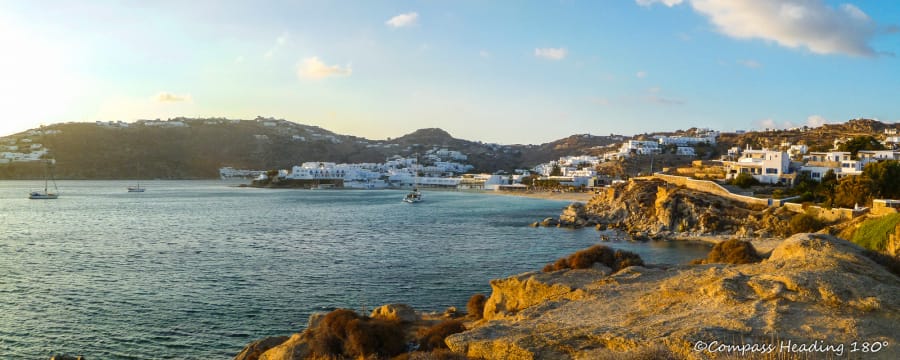Mykonos with Wintry Winds

We had been dodging strong northerly winds for a week in Naxos during the second half of October. During a short calm break, we paid a brief visit to the island of Delos before having to hunker down for the next windy spell. There appeared to be some sheltered bays on the south side of Mykonos, so we headed there. Mykonos is one of the most touristy islands in the Cyclades, but perhaps this late in the season it might not be quite so crowded.
During the summer and autumn, we had learned to avoid the strongest bursts of meltemi, which normally last a few days at a time. It’s an annual weather pattern in the Aegean Sea that prevails from June to September. Usually, this northerly wind starts in the morning and calms down around sunset. Sometimes it blows continuously for a few days. Lately, the windy periods have gotten longer, the winds stronger, and the meltemi season is starting earlier and lasting later in the year than before. I don’t know whether these northerlies that were constantly bugging us in October were meltemi or early winter winds, but they were much too fierce and cold to our liking.
We found a nice spot close to a beach in Platis Gialos, a tourist resort. The island’s main town was some five kilometres away. The first night was still calm, but the next morning the wind rose as if someone had flicked a switch. We’re quite used to the sudden changes in the Mediterranean weather but it’s always a little startling how quickly it can happen. The wind was so fresh it managed to kick up a chop even though we weren’t too far from the beach. Aina’s anchor snubbers squeaked and her rigging howled and she didn’t seem comfortable at all – and neither did we. For a couple of days, we didn’t dare to leave the boat to go ashore. What if she decided to take off without us?

A little later we felt brave enough to go for short walks in the vicinity. The disco music that had entertained us the first night until the wee hours had quieted, but there were still quite a few sea bathers on the beach.
Finally, it was time to visit Mykonos town. Just like on most Cycladic islands, the capital goes by the same name as the island but is often called Chora. We stepped off the bus at the foot of the famous windmills of Mykonos, a good place to start our sightseeing tour. Seven windmills stand side by side near the shore, five of them beautifully restored. The oldest of them have stood there since the 16th century, facing the prevailing northerly wind. For centuries they would grind wheat and prosperity to the islanders.
There’s a nice view from the windmills towards “Little Venice”. Old houses have been built at the water’s edge, and many of them have pretty wooden balconies. The atmosphere is very similar to another Venetian town we visited in 2019 – Cefalú in Sicily.

Mykonos town is still a medieval maze of whitewashed heaps of houses and paved alleys. It’s nice to just meander and get lost in it. The Cycladic towns were purposefully built like this, difficult to navigate, to protect them from pirates and other looters. Mykonos is a bit too popular to wander around in peace, though. Even in October, it was still busy with tourists. The streets are filled with souvenir shops and look nice enough. However, most of the shops seem to sell cheap plastic stuff and it’s very hard to find anything authentic, local, traditional or handmade, despite these words being advertised everywhere.
Mykonos was under Venetian rule for centuries, along with the rest of the Cyclades. The Venetian castle built to guard the city is nowadays a pile of stone ruins in a handsome place between the old residential quarters and the harbour. We found an interesting photo exhibition inside the castle walls, showing glimpses of the town’s history.

The photos show ordinary townsfolk doing ordinary things – a rubbish collector, a house painter, seamen and passengers on a ferry, locals having a party. And then, a 1950s French tourist in her hotpants – she must have been just as exotic to the locals as the Greek town was for a tourist in those days.




Panagia Paraportiani – Our Lady of the Side Gate – is an old church next to the castle. It’s comprised of five churches side by side and on top of each other. It was built in stages, from the 15th to the 17th century. The white walls seemed to radiate light on a gloomy, cloudy day.

Carefree cats of Mykonos enjoying their afternoon nap. Not all cats on the Greek islands have been this happy and healthy-looking, but here they seemed well taken care of. The three musketeers kept snoring while I photographed them from every side. One had found a warm spot in the sun.
After a week the wild northerly winds turned into something a little friendlier. We still hadn’t decided where to sail next. We hadn’t decided where to spend the winter months, either. For several weeks now, the Aegean had been trying to tell us that winter was coming – perhaps it was time for us to listen. We didn’t have too many choices around here. Mainland Poros, with its large protected bay, was one possibility, but perhaps not in all winds. Kilada and Porto Cheli a little further south have good anchorages. We had visited them both during the late summer but hadn’t found them particularly appealing. Some very good marinas could be found on the islands further east from where we were, but not quite within our budget.

One place seemed interesting enough, with a possibility to spend the winter at anchor: Crete. After weighing our options, it seemed like the best choice, particularly since it was 250 kilometres further south! It would still be warm down there, and the Cretan winter climate is supposed to be mild. It would be rainy, of course, but warmer than we were used to during our previous winters in Greece. So – Crete it would be! The last day of October, early Sunday morning, we weighed anchor and left Mykonos behind. Aina sailed out to the grey sea, with a grey sky hanging over her. But the wind seemed to cooperate. We would make landfall the next day, perhaps in the afternoon, hopefully before nightfall – the first of November.

- Escaping winter to Crete – Spinalonga and Elounda March 7, 2022
- Naxos – the Greatest of the Cyclades November 22, 2021
- Kythira – a Bend in the Road July 12, 2022


















